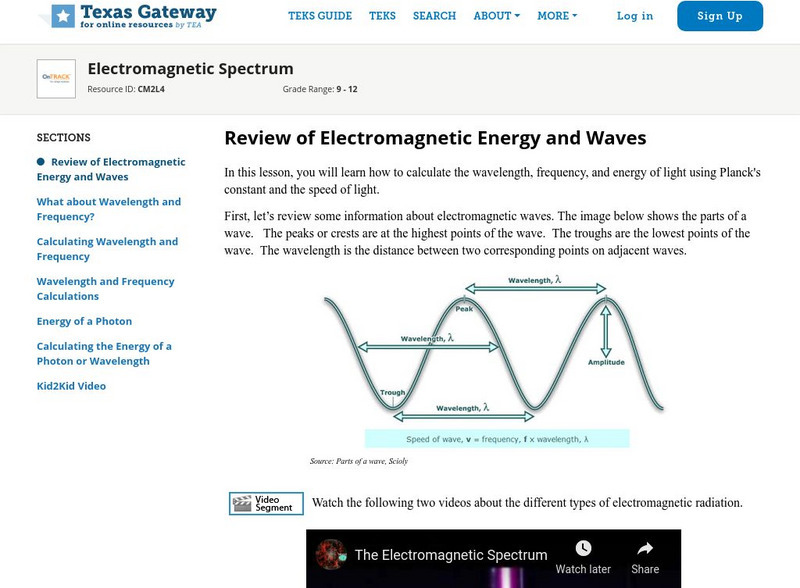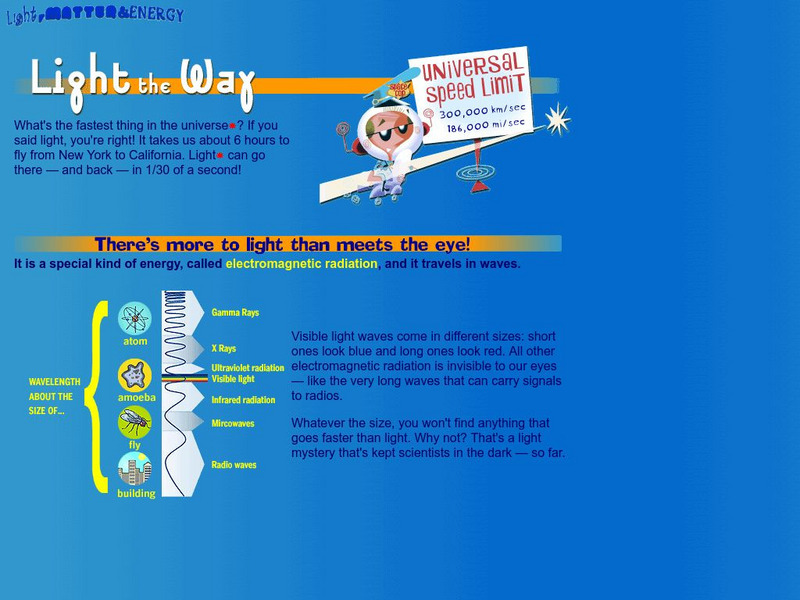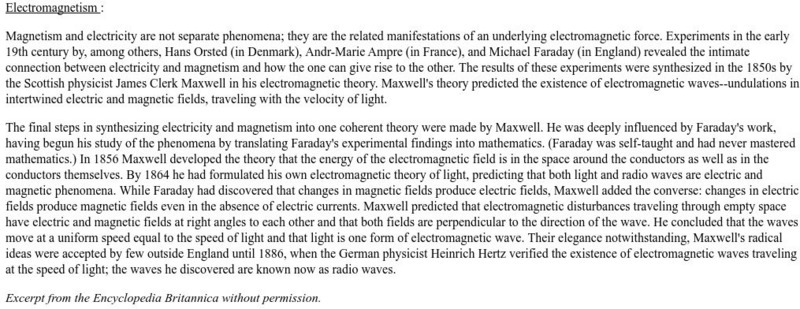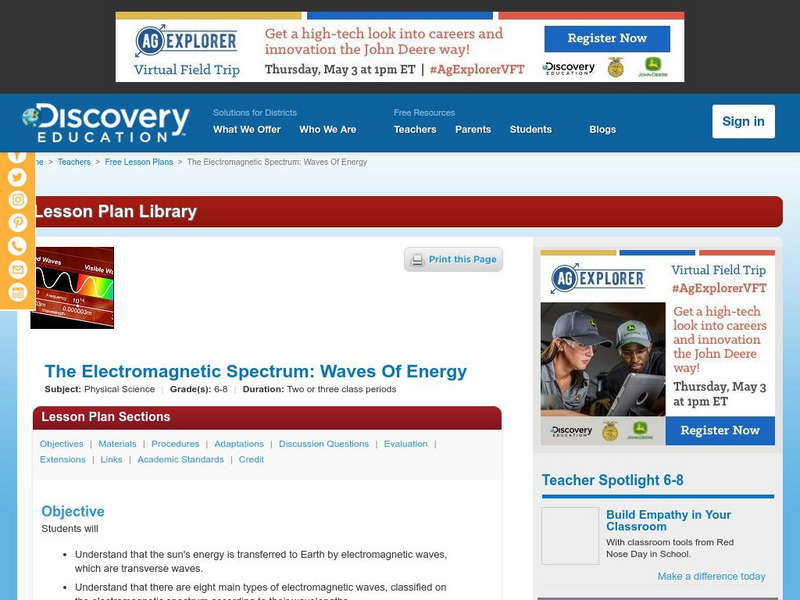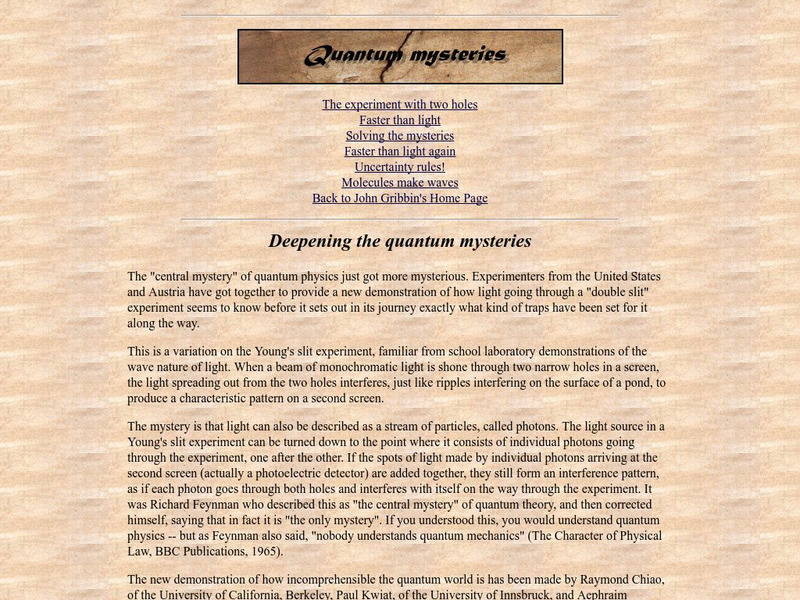Hi, what do you want to do?
Science Struck
Science Struck: Kinetic Energy Formula
Explains what is meant by kinetic energy and demonstrates how to use the formulas for a point mass moving at less than the speed of light, for rotational motion, and for a mass moving at a relativistic speed. Includes interactive...
Texas Education Agency
Texas Gateway: Electromagnetic Spectrum
This tutorial explores using Planck's constant and the speed of light to calculate the wavelength, frequency, and energy of light.
American Museum of Natural History
American Museum of Natural History: O Logy: Light, Matter, Energy: Light the Way
What is electromagnetic radiation and how does it work? Review a captioned graphic that explains electromagnetic radiation and the visible and invisible types of radiation on the electromagnetic spectrum.
University of Oregon
University of Oregon: Electromagnetism
A solid summary from the University of Oregon of the work of James Maxwell Clerk, Michael Faraday, and others in the field of electric and magnetic phenomena. This is a fine essay.
TED Talks
Ted: Ted Ed: Sunlight Is Way Older Than You Think
It takes light a zippy eight minutes to reach Earth from the surface of the Sun. But how long does it take that same light to travel from the Sun's core to its surface? Oddly enough, the answer is many thousands of years. Sten Odenwald...
Physics Aviary
Physics Aviary: Wavelength Lab
This lab is designed to have students investigate the relationship between the speed of a wave, the frequency of the wave and the wavelength of the wave. Students can vary wave speed and frequency. Each of these should be varied while...
CK-12 Foundation
Ck 12: Physical Science: Refraction
[Free Registration/Login may be required to access all resource tools.] Refraction of light in matter and how light changes its speed and angle of refraction according to the type of medium it is travelling through.
Ducksters
Ducksters: Physics for Kids: Light
Kids learn about the science of light. Energy made of waves and particles called photons traveling at the top speed in the universe. What is refraction? The difference between transparent, translucent, and opaque.
PBS
Pbs Learning Media: Think Like Einstein
This interactive activity from the NOVA Web site challenges you to think like Einstein and understand how time travel might be possible.
Chem4kids
Chem4 Kids: Symbols in Chemical Equations
Chem4Kids! provides an overview of the symbols representing numerical values in chemical equations. Each symbol is defined and described.
Discovery Education
Discovery Education: The Em Spectrum: Waves of Energy
Young scholars are introduced to the electromagnetic spectrum through this group research activity. Each group investigates a different wavelength range within the em spectrum and reports back to class. Discussion ideas also included.
Wolfram Research
Wolfram Science World: Maxwell, James
This ScienceWorld site describes the Scottish mathematician and physicist James Maxwell (1831-1879) who published physical and mathematical theories of the electromagnetic field.
Rice University
Galileo Project: Ole Christensen Roemer
Factsheet and chronology of Ole Christensen Roemer, who first measured the speed of light.
Other
Quantum Mysteries: Deepening Quantum Mysteries
Although it is arguably the most successful theory in physics, quantum physics has often baffled and confounded both its practitioners and the general public. This informative website discusses the types of mysteries, which still plague...
TED Talks
Ted: Ted Ed: What Are Gravitational Waves?
In September 2015, scientists witnessed something never seen before: two black holes colliding. Both about 30 times as big as our Sun, they had been orbiting each other for millions of years. A fraction of a second before the crash, they...
PBS
Pbs Teachers: Math Space Odyssey: How Long Is a Light Year?
This lesson helps students to demonstrate the ability to use a light year as a standard of measurement to calculate time and distance from the earth. They will also solve problems based on light years.
Wolfram Research
Wolfram Science World: Roemer, Olaf
This ScienceWorld site provides a biographical sketch of Olaf Roemer and describes his most notable scientific discoveries such as the first good estimate of the speed of light.
Physics4kids
Physics 4 Kids: Where Traditional Physics Stops
We're about to move into the modern age of physics. In the early 1800's, scientists began examining the basis of matter, space, and time. Sometimes it gets very confusing, but the big idea is that Newton's physics describe about 90% of...
NASA
Nasa: From Stargazers to Starships: Energy
Demonstrates how principles of kinetic energy, potential energy and energy conservation can be used to determine the speed of a descending object if given its initial height. Further discussion of other topics such as heat and...
Open Curriculum
Open Curriculum: Velocity and Relative Motion
An illustrated article helps physics students learn about center of mass and velocity, and define the concept of inertia.
TED Talks
Ted: Ted Ed: Praseodymium: Periodic Table of Videos
The team at Periodicvideos has created a TED-Ed Lesson for every element of the periodic table. This one is about praseodymium, an element used to filter harmful light. Praseodymium has even helped slow light's speed down to a mere 300...
NASA
Nasa: Imagine the Universe: "Nasa Detects One of Closest"
Site provides the article, "NASA Detects One Of Closest And Brightest Gamma Ray Bursts." Provides links to learn more about gamma rays and black holes as well as other resources.
CPALMS
Moving on Up
[Free Registration/Login Required] During this MEA simulation, kindergarten students will be preparing for a move to another state. Students must work in cooperative groups as they determine which moving company will be the best for...
TED Talks
Ted: Ted Ed: How to Take a Great Picture
For manual photography, the aperture, shutter speed, and ISO sensitivity can all be manipulated to get just the right amount of light. Carolina Molinari suggests the best exposure for an action photo, a stunning portrait, or a nighttime...






